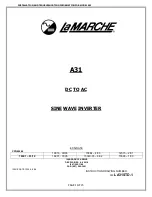
SAMLEX AMERICA INC. | 67
i
INFO
It is recommended that “GSCM-Mini” Series of Generator Start / Stop Control Module, appropriate for the
generator to be used, may ordered directly from Atkinson Electronics www.atkinsonelectronics.com
Based on the Generator Start Logic contained in of one of the selected Options 2, 3 or 4 (
under programming
parameter "RELAY FUNCTION"
)
[See Sections 4.8.2.5.2 in EVO-RC-PLUS Remote Control Manual]
, the Status Relay
will be switched ON (
energized
), its “Common” and “NO” contacts will close and the external Generator Start / Stop
Control Module will initiate automatic starting of the Generator. Once the Generator has started and starts feeding
AC output to EVO™ (
within the programmed limits of voltage and frequency
), the EVO™ will be synchronized with
the Generator and once synchronization is completed, the load will be transferred instantly
(within 1 ms)
to the
Generator at Zero Crossing of the voltage waveform for seamless transfer and for better protection of Transfer Relay
contacts. The EVO™ will now operate in “Charging Mode” with the AC power from the Generator charging the
batteries as well as providing power to the AC load(s).
Based on the Generator Stop Logic contained in one of the selected Options 2, 3 or 4 under programming parameter "RELAY
FUNCTION"
[See Sections 4.8.2.5.2 in EVO-RC-PLUS Remote Control Manual]
, the Status Relay will be switched OFF (
de-
energized
), its “Common” and “NO” contacts will open and the external Generator Auto Start Control Module will initiate
automatic stopping of the Generator. When AC output of the generator is shut down, battery charging and Generator pass-
through will stop and the EVO™ will automatically transfer the AC load(s) to the “Inverter Section” within 16 ms.
4.8 MODES OF OPERATION
4.8.1 Charging Mode
As long as the external AC input power is available and is within the programmed limits of voltage and frequency, it
is passed through to the AC load through the Transfer Relay Section
(See Section 4.5)
. At the same time, the Battery
Charger Section converts the external AC input power from the Grid/Generator to DC power to charge the 48 VDC
Battery Source.
4.8.2 Inverting Mode
If at any instant, the external AC input power is interrupted or is not within the programmed limits of voltage and
frequency, the Transfer Relays are de-energized and the load is transferred to the Inverter Section and internal battery
charging is terminated. This is called the Inverting Mode.
4.8.3 Power Saving Mode
Power Saving Mode related to inverters is a function designed to conserve battery power when the inverter is in ON
condition and no AC loads are connected to it or, AC loads are connected to it but have been switched OFF. This
condition is also called
“No Load Condition”
.
When an inverter is operating under “
No Load Condition
”, it will consume a small amount of input power from the
battery to keep all internal circuits alive and be ready to deliver the full rated output voltage and power to the load
once the load is switched ON. This input power drawn from the battery when no load is being supplied by the inverter
is called the “No Load Power Draw” (
also called “Idle Power” or “Self Power Consumption
). This “No Load Power
Draw” is proportional to the size of the inverter e.g. a 150 Watt inverter may have “No Load Power Draw” of around
6W and a 3000W may have “No Load Power Draw” of around 30W.
This power is wasted and drains the battery
unnecessarily. It is, therefore, desirable to reduce the “No Load Power Draw” to the minimum.
SECTION 4 |
General Description & Principles of Operation
Summary of Contents for Evolution EVO-4248SP
Page 115: ...SAMLEX AMERICA INC 115 NOTES...
















































